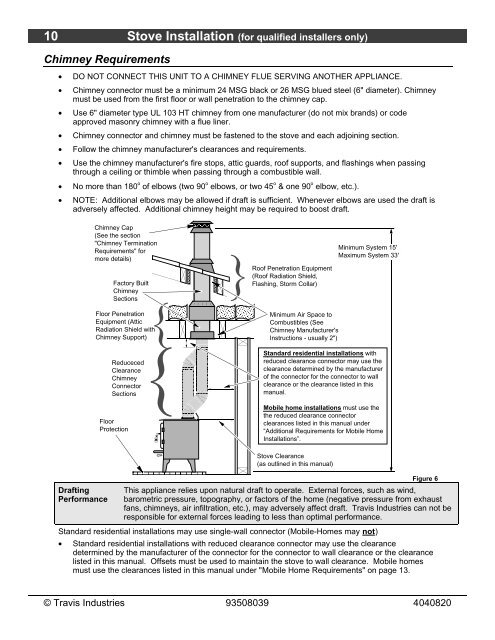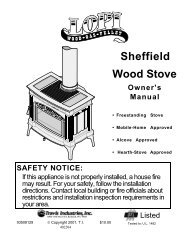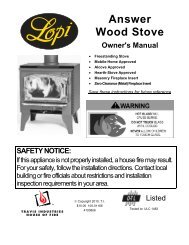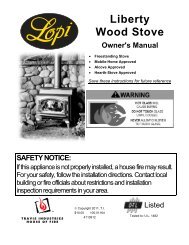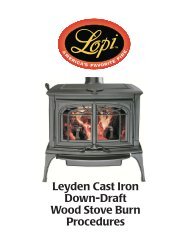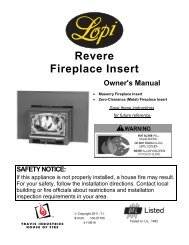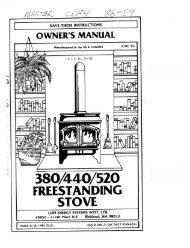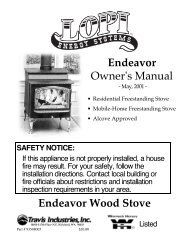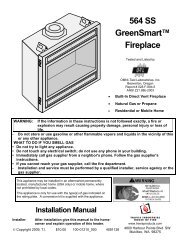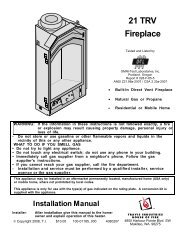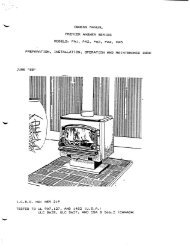P A T R I O T Wood Stove - Lopi
P A T R I O T Wood Stove - Lopi
P A T R I O T Wood Stove - Lopi
Create successful ePaper yourself
Turn your PDF publications into a flip-book with our unique Google optimized e-Paper software.
10 <strong>Stove</strong> Installation (for qualified installers only)<br />
Chimney Requirements<br />
• DO NOT CONNECT THIS UNIT TO A CHIMNEY FLUE SERVING ANOTHER APPLIANCE.<br />
• Chimney connector must be a minimum 24 MSG black or 26 MSG blued steel (6" diameter). Chimney<br />
must be used from the first floor or wall penetration to the chimney cap.<br />
• Use 6" diameter type UL 103 HT chimney from one manufacturer (do not mix brands) or code<br />
approved masonry chimney with a flue liner.<br />
• Chimney connector and chimney must be fastened to the stove and each adjoining section.<br />
• Follow the chimney manufacturer's clearances and requirements.<br />
• Use the chimney manufacturer's fire stops, attic guards, roof supports, and flashings when passing<br />
through a ceiling or thimble when passing through a combustible wall.<br />
• No more than 180 o of elbows (two 90 o elbows, or two 45 o & one 90 o elbow, etc.).<br />
• NOTE: Additional elbows may be allowed if draft is sufficient. Whenever elbows are used the draft is<br />
adversely affected. Additional chimney height may be required to boost draft.<br />
Drafting<br />
Performance<br />
Chimney Cap<br />
(See the section<br />
"Chimney Termination<br />
Requirements" for<br />
more details)<br />
Factory Built<br />
Chimney<br />
Sections<br />
Floor Penetration<br />
Equipment (Attic<br />
Radiation Shield with<br />
Chimney Support)<br />
Reduceced<br />
Clearance<br />
Chimney<br />
Connector<br />
Sections<br />
Floor<br />
Protection<br />
<br />
<br />
<br />
<br />
}<br />
}<br />
<br />
<br />
<br />
<br />
<br />
<br />
<br />
<br />
<br />
<br />
<br />
<br />
<br />
<br />
<br />
} Roof Penetration Equipment<br />
(Roof Radiation Shield,<br />
Flashing, Storm Collar)<br />
Minimum Air Space to<br />
Combustibles (See<br />
Chimney Manufacturer's<br />
Instructions - usually 2")<br />
Standard residential installations with<br />
reduced clearance connector may use the<br />
clearance determined by the manufacturer<br />
of the connector for the connector to wall<br />
clearance or the clearance listed in this<br />
manual.<br />
Mobile home installations must use the<br />
the reduced clearance connector<br />
clearances listed in this manual under<br />
“Additional Requirements for Mobile Home<br />
Installations”.<br />
<strong>Stove</strong> Clearance<br />
(as outlined in this manual)<br />
Minimum System 15'<br />
Maximum System 33'<br />
Figure 6<br />
This appliance relies upon natural draft to operate. External forces, such as wind,<br />
barometric pressure, topography, or factors of the home (negative pressure from exhaust<br />
fans, chimneys, air infiltration, etc.), may adversely affect draft. Travis Industries can not be<br />
responsible for external forces leading to less than optimal performance.<br />
Standard residential installations may use single-wall connector (Mobile-Homes may not)<br />
• Standard residential installations with reduced clearance connector may use the clearance<br />
determined by the manufacturer of the connector for the connector to wall clearance or the clearance<br />
listed in this manual. Offsets must be used to maintain the stove to wall clearance. Mobile homes<br />
must use the clearances listed in this manual under "Mobile Home Requirements" on page 13.<br />
© Travis Industries 93508039 4040820


